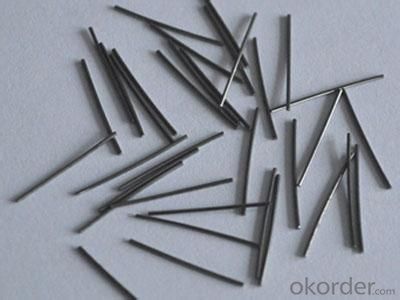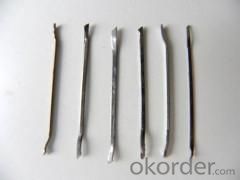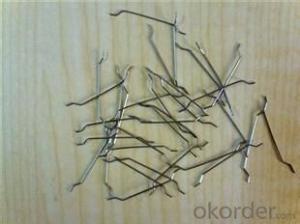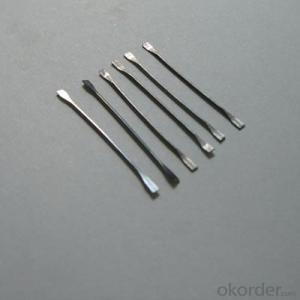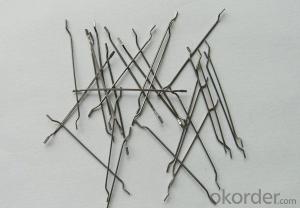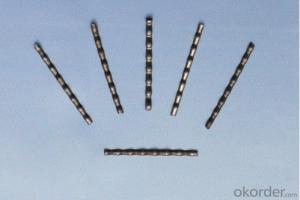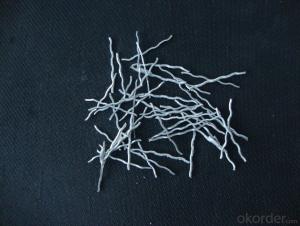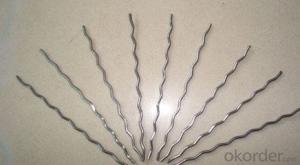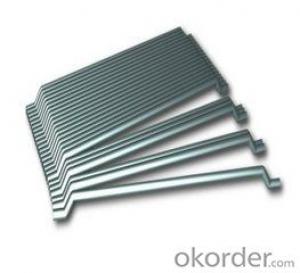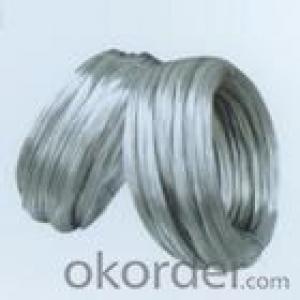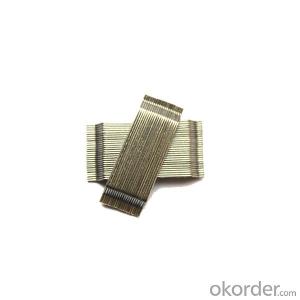Melt Extract Stainless Steel Fiber Reinforced Concrete with Admixtures
- Loading Port:
- Tianjin
- Payment Terms:
- TT OR LC
- Min Order Qty:
- 1000 kg
- Supply Capability:
- 250000 kg/month
OKorder Service Pledge
OKorder Financial Service
You Might Also Like
Quick Details
Place of Origin: Shandong, China (Mainland), Shandong, China (Mainland)
material: steel wire
type: wavy steel fiber
shape: corrugated flat fiber
usage: concrete reinforcement
appearance: clear and bright
Product features
steel fiber are for concrete construction, greatly improves concrete bonding and tensile strength .
The steel fiber is made of high-quality low carbon steel wire,with the characteristic of the high tensile strength,good toughness,etcs.This product is widely used in the construction fields for concrete reinforcement
or the shotcrete for tunnle.According to the standard of JG/T3046-1999 Steel Fiber Concrete, YB/T 151-1999 Steel Fiber for Concrete and ASTM AB820-90 Steel Fiber for the Fiber-Rinforced Concrete.
Specifications
| The Specification of Hooker Ends Steel Fiber | ||||
| TYPE | Diameter(mm) | Length(mm) | Length/Diameter | Tensile strength |
| LB-60/60 | 1.0 | 60 | 60 | >=1000Mpa |
| LB-50/50 | 1.0 | 50 | 50 | >=1000Mpa |
| LB-65/60 | 0.9 | 60 | 65 | >=1000Mpa |
| LB-55/50 | 0.9 | 50 | 55 | >=1000Mpa |
| LB-80/60 | 0.75 | 60 | 80 | >=1000Mpa |
| LB-45/35 | 0.75 | 35 | 45 | >=1000Mpa |
| LB-55/30 | 0.55 | 30 | 55 | >=1000Mpa |
| LB-60/30 | 0.5 | 30 | 60 | >=1000Mpa |
| LB-50/25 | 0.5 | 25 | 50 | >=1000Mpa |
| LB-60/25 | 0.4 | 25 | 60 | >=1000Mpa |
Picture
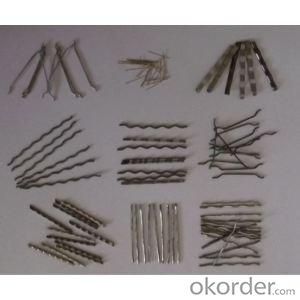
steel fiber for concrete reinforcement
FAQ
we can produce any type steel fiber and of course we can make production according to your requirement
we have specilize in this field for almost 10 years ,with good quality and competitive price
- Q: Can melt extract stainless steel fiber improve the durability of concrete in acidic environments?
- Indeed, the durability of concrete in acidic environments can be improved by using melt extract stainless steel fiber. The exceptional corrosion resistance properties of stainless steel fibers make them highly resistant to chemical attacks, even in acidic conditions. When added to concrete mixtures, these fibers act as reinforcement, enhancing the overall strength and durability of the concrete. In acidic environments, concrete tends to deteriorate due to chemical reactions between acidic substances and the cement paste. This deterioration can result in the loss of structural integrity and premature failure of the concrete. However, incorporating melt extract stainless steel fibers into the concrete significantly improves its corrosion resistance, thereby prolonging its service life in acidic conditions. The inclusion of stainless steel fibers creates a protective barrier within the concrete, preventing the penetration of acidic substances and minimizing chemical reactions. Moreover, these fibers improve the strength and toughness of the concrete matrix, making it more resistant to cracking and spalling that may occur in acidic environments. Additionally, melt extract stainless steel fibers enhance the overall durability of concrete by increasing its resistance to other forms of deterioration, such as freeze-thaw cycles, abrasion, and impact. This further contributes to the longevity of the concrete in acidic environments. Overall, the addition of melt extract stainless steel fiber to concrete mixtures offers a cost-effective solution for enhancing performance and extending the service life of concrete structures exposed to acidic conditions.
- Q: What is the recommended fiber orientation for melt extract stainless steel fiber in concrete?
- The recommended fiber orientation for melt extract stainless steel fiber in concrete is typically a random or dispersed distribution. This means that the fibers should be evenly distributed throughout the concrete matrix, without any specific orientation or alignment. This random distribution helps to enhance the overall performance of the fiber-reinforced concrete by providing uniform reinforcement in all directions. It improves the crack resistance, toughness, and durability of the concrete, allowing it to better withstand tensile and flexural stresses. Moreover, the random orientation also helps to minimize fiber clumping or balling, ensuring a more effective dispersion and integration of the stainless steel fibers within the concrete mixture.
- Q: Is melt extract stainless steel fiber compatible with various types of cement?
- Various types of cement are compatible with melt extract stainless steel fiber. These fibers are specially designed to boost the effectiveness of cement-based materials, such as concrete. They offer reinforcement, enhance durability, improve crack resistance, and strengthen the overall cement matrix. Melt extract stainless steel fibers possess exceptional chemical resistance, enabling them to maintain their integrity and effectiveness even when exposed to different types of cement and aggressive substances. Consequently, whether it's Portland cement, fly ash cement, or any other variety, melt extract stainless steel fibers can effectively enhance their properties and performance.
- Q: What is melt extract stainless steel fiber?
- Melt extract stainless steel fiber is a reinforcing fiber made from stainless steel through a process known as melt extraction. In this process, stainless steel is melted and quickly solidified to create fine, continuous fibers. These fibers are commonly utilized as reinforcement in different applications, such as concrete and refractory materials. They are renowned for their exceptional strength, durability, and ability to resist corrosion, making them an excellent choice for challenging environments. The incorporation of melt extract stainless steel fibers in concrete enhances its mechanical properties, including flexural strength, impact resistance, and crack resistance. This reinforcement improves the overall performance and longevity of concrete structures, especially in situations where high strength and durability are necessary, such as industrial flooring, tunnel linings, and bridge decks. In refractory materials, melt extract stainless steel fibers are employed to enhance the material's thermal shock resistance and mechanical strength. These fibers can withstand extreme temperatures, making them suitable for applications in furnaces, kilns, and other environments with high temperatures. Overall, melt extract stainless steel fibers offer a versatile and dependable solution for reinforcing various materials, providing increased strength, durability, and resistance to corrosion and thermal shock.
- Q: Can melt extract stainless steel fiber be used in architectural precast panels?
- Architectural precast panels can indeed utilize melt extract stainless steel fiber. These fibers are commonly incorporated into the concrete mixture during production to bolster the panels' mechanical characteristics. By enhancing the tensile strength, flexural strength, and durability of the panels, the stainless steel fibers effectively heighten their resistance to cracking and overall performance. Furthermore, the inclusion of stainless steel fibers can also lessen the panels' weight, simplifying their handling and installation. Consequently, melt extract stainless steel fiber proves to be a fitting choice for reinforcing architectural precast panels.
- Q: How does melt extract stainless steel fiber affect the permeability of concrete?
- The permeability of concrete is significantly affected by the inclusion of melt extract stainless steel fibers. These fibers, which are slender and elongated strands, are incorporated into concrete mixtures during the mixing process. Once evenly distributed throughout the concrete, they form a three-dimensional network that enhances the overall strength and durability of the material. One of the primary advantages of using stainless steel fibers is the reduction in concrete permeability. Concrete is naturally a porous substance, allowing the passage of liquids and gases. However, the addition of stainless steel fibers helps to seal these pores and decrease the permeability of the concrete. The melt extract stainless steel fibers serve as a physical barrier, preventing the infiltration of water, chemicals, and other harmful substances into the concrete. This is particularly crucial in environments where the concrete is exposed to harsh conditions, such as marine or industrial settings. By reducing the permeability of concrete, the inclusion of stainless steel fibers also enhances its resistance to corrosion and deterioration. These fibers help to limit the penetration of moisture and aggressive agents that can cause the reinforcement steel within the concrete to rust. Consequently, the lifespan of the concrete structure is prolonged, and maintenance expenses are minimized. Moreover, the decreased permeability of concrete with stainless steel fibers also improves its ability to withstand freeze-thaw cycles. When water enters the concrete and freezes, it expands, generating internal pressure and leading to cracks and deterioration. The presence of stainless steel fibers restricts the entry of water, thus reducing the potential for freeze-thaw damage. In conclusion, melt extract stainless steel fibers have a positive impact on the permeability of concrete. They diminish the flow of water and other harmful substances, improving the durability, resistance to corrosion, and ability to withstand freeze-thaw cycles of the concrete. By enhancing these properties, stainless steel fibers contribute to the overall performance and longevity of concrete structures.
- Q: Is melt extract stainless steel fiber compatible with all types of shotcrete mix designs?
- Compatibility of melt extract stainless steel fiber with all types of shotcrete mix designs is not guaranteed. Several factors, including fiber length, aspect ratio, dosage, and desired concrete properties, influence the fiber's compatibility with a specific mix design. Shotcrete applications commonly utilize melt extract stainless steel fibers to enhance concrete strength, toughness, and durability. However, careful selection of fiber length and dosage is necessary to ensure compatibility with the specific shotcrete mix design. Various shotcrete mix designs possess different requirements and properties, such as workability, slump, and setting time. Some mix designs may contain higher water content, which can impact the bonding between fiber and concrete matrix, resulting in reduced performance. Consulting with the manufacturer of melt extract stainless steel fiber and the shotcrete mix design supplier is crucial to determine compatibility. They can offer guidance on the appropriate dosage and fiber length to achieve desired results and ensure compatibility with the specific mix design. Additionally, conducting tests and trials on a small scale can aid in evaluating fiber compatibility and performance in the chosen shotcrete mix design.
- Q: Can melt extract stainless steel fiber be used in seismic-resistant concrete applications?
- Yes, melt extract stainless steel fiber can be used in seismic-resistant concrete applications. Stainless steel fibers are commonly used as reinforcement in concrete to enhance its strength, durability, and ductility. In seismic-resistant concrete applications, stainless steel fibers help to improve the concrete's resistance to cracking and enhance its ability to withstand the dynamic forces generated during an earthquake. The melt extract stainless steel fibers are particularly suitable for such applications due to their high tensile strength, corrosion resistance, and ability to disperse uniformly within the concrete matrix. They effectively reinforce the concrete and provide enhanced crack control, reducing the risk of structural failure during seismic events. Therefore, using melt extract stainless steel fiber in seismic-resistant concrete can significantly improve the overall performance and safety of the structure.
- Q: Does melt extract stainless steel fiber improve the fatigue resistance of concrete?
- Yes, melt extract stainless steel fiber can improve the fatigue resistance of concrete. The addition of stainless steel fibers enhances the tensile strength and ductility of concrete, thereby reducing crack formation and propagation under cyclic loading. This improves the fatigue resistance of the concrete, making it more durable and capable of withstanding repeated stress cycles without failure.
- Q: Does melt extract stainless steel fiber improve the fire resistance of concrete?
- Indeed, the fire resistance of concrete is enhanced by melt extract stainless steel fiber. By incorporating stainless steel fibers into the concrete, the material gains reinforcement and an enhanced level of strength and durability. In the event of a fire, these fibers play a crucial role in impeding the transmission of heat, thus safeguarding the concrete from cracking or spalling. Moreover, the remarkable melting point of stainless steel guarantees that it retains its structural integrity even in the face of extreme temperatures. Consequently, the fire resistance of the concrete is significantly improved, rendering it a dependable and secure construction material suitable for areas prone to fires.
Send your message to us
Melt Extract Stainless Steel Fiber Reinforced Concrete with Admixtures
- Loading Port:
- Tianjin
- Payment Terms:
- TT OR LC
- Min Order Qty:
- 1000 kg
- Supply Capability:
- 250000 kg/month
OKorder Service Pledge
OKorder Financial Service
Similar products
Hot products
Hot Searches
Related keywords


